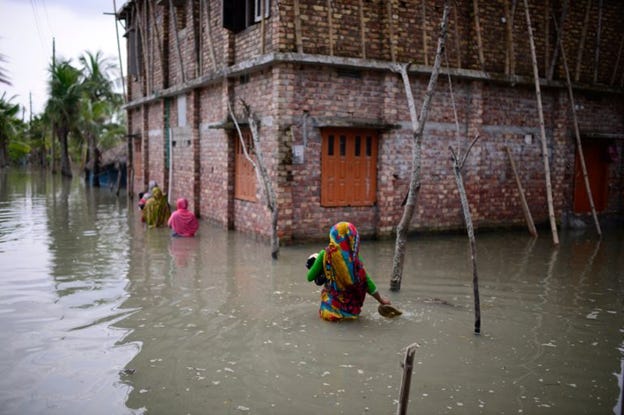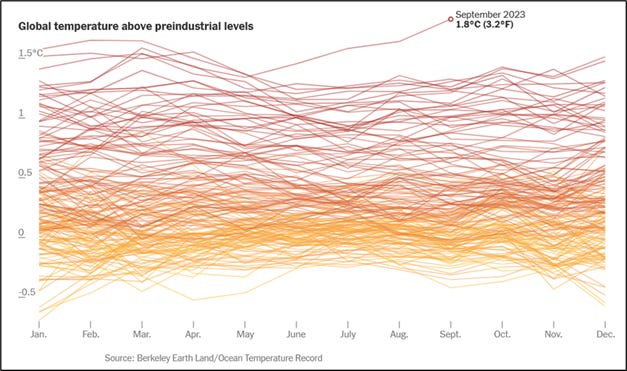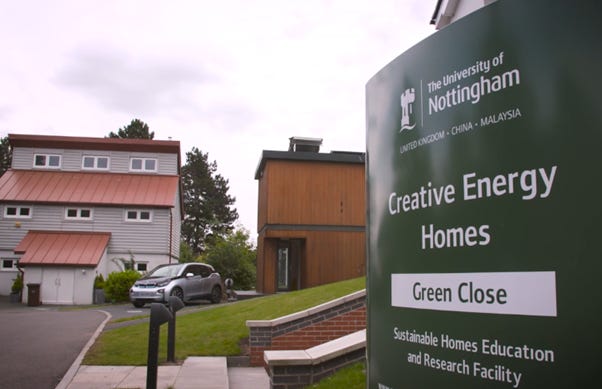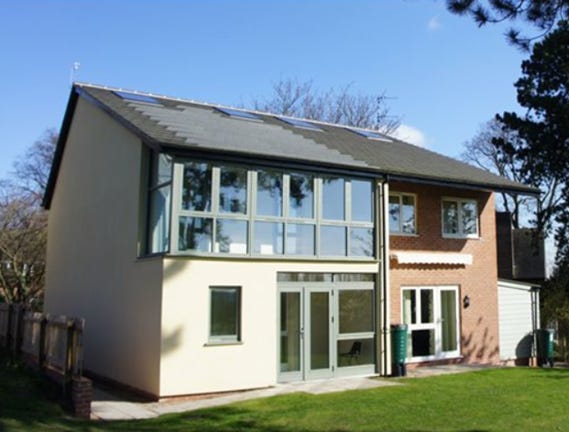Climate change is literally at our doorstep. In fact, it is flooding over the doorstep, through the house, and down the stairs. How do we make things safer?


Floodwaters caused by global warming are devastating
villages worldwide, such as this community in Bangladesh.
These are the threats that drove Leonora Camner to help form the ClimateSafe Villages organization; her primary concern was “my two little girls.”
“Our children’s future is uncertain. Climate change is a serious threat to our way of life. It’s clear that things can no longer continue with ‘business as usual,’ she stated. “Now we have major water reservoirs going dry and unprecedented scales of fire. At other extremes, we are seeing sea levels rise from warm temperatures and melting ice.”
“Without change, the most probable future would be suffering, disruption, and likely death; we need to protect our families, children, and grandchildren.”
Leonora is right that her girls are entering a future unlike anything seen before:

The challenge is intimidating. 2023 is almost certain to be the hottest year since reliable global records began in the mid-1800s and probably for the past 2,000 years. This acceleration in warming is owed to human sources of greenhouse gas emissions.
According to the Global Ecovillage Network, climate-safe or eco-village is an intentional, traditional or urban community that is consciously designed through locally owned participatory processes in all four dimensions of sustainability (social, cultural, ecological, and economical) to regenerate social and natural environments. The term “eco-village” was introduced by Georgia Tech Professor George Ramsey in a 1978 address, “Passive Energy Applications for the Built Environment.”
Climate models have consistently found that once we get emissions down to net zero, the world will largely stop warming. It may take centuries to cool back down, but the damage will cease.
It’s now clear that we can control how warm the planet gets over the coming decades. Climate models have consistently found that once we get emissions down to net zero, the world will largely stop warming; there is no warming that is inevitable
There is reason for hope. The world is on the brink of a clean energy transition that could shift the balance on carbon emissions. The International Energy Agency recently estimated that $1.8 trillion will be invested in clean energy technologies like renewables, electric cars and heat pumps in 2023, up from roughly $300 billion a decade ago.
Another reason for hope is the construction of ‘climate safe villages’.
“Our ClimateSafe Villages movement is dedicated to self-sufficiency, the adoption of green technologies, and fostering a supportive community culture,” said Leonora. “Our hope is that by bringing people together in hopeful, resilient, and sustainable communities, we can promote the changes that can bring about larger-scale impact.”
“ClimateSafe Villages is done at a scale that allows individuals to move mountains — a grain at a time.”
CSV equips individuals and families with significant climate change resilience, fostering a sustainable living environment that can be scaled up to communities throughout the world.
“Our first CSV site is Bellingham, Washington.”
Located between Vancouver and Seattle, Bellingham is the flagship project. The plan for CSV is to create, over time, a comprehensive rural eco-village that operates as a proof of concept for sustainable, resilient living. It further extends its impact through an associated network of ClimateSafe Villages in various regions, creating a global community interconnected through shared principles and knowledge.
How does one get involved in the CSV movement? Leonora advises that people should start by joining the virtual network. There they will get access to the guides and materials needed to do ‘needs assessments’ and start to build a knowledge and resource base. Interaction with others will help design community actions that lead to food security, energy systems and other critical measures. Then help will be given to expanding your community’s membership and evaluating your progress.
“This is not the kind of project that gets ‘completed’,” warns Leonora. “Change and adaptation are constant. As it moves forward, it is an incredibly rewarding experience.”
Bellingham is in the planning phase at the moment. Designing the structures is one of the first steps. This includes the physical design of the structures work with existing firms on resilient guidelines. The buildings are being set up to be completely energy self-sufficient.
“We already have volunteers from almost every part of the world: Asia, Africa, Australia….We are aiming to be a global support network for climate villages.”
Interest in CSVs is global because few parts of the world are immune from coming climate change. On the opposite side of the world from Bellingham is Nottingham University in the UK. Climate-driven food shortages could cause civil unrest in the UK, with 40 per cent of the experts warning that this is possible within the next 10 years; 80 per cent say it will happen over the next 50 years. A shortage of popular staple carbohydrates such as wheat, bread, pasta, and cereal is most likely to trigger future unrest.
Extreme weather events — such as storms, flooding and drought — are believed to be the most likely coming causes of food shortages and food distribution issues.
Professor Saffa Riffat is at the University of Nottingham, one of the top 100 universities in the world and the study hub for almost 50,000 students from more than 150 countries. Its Creative Energy Homes has been developed by members of the Building, Energy and Environment Research Group.
Working with a number of industrial partners, Riffat’s group is researching methods to reduce the impact of those technologies we take for granted, such as ventilation, heating, cooling and power.
It addresses the key areas:
· Sustainable building design;
· Sustainable energy technologies;
· Sustainable urban living; and
· Smart and Innovative materials.
The Creative Energy Homes project brings together several of these themes. Micro-smart grids, energy storage, demand-side management and occupants’ acceptance of innovative technologies are piloted in the seven-house development. It us a living test-site for leading firms to work with the University to investigate the integration of energy efficient technologies into houses.

The project is being largely funded by industry, who came to the university seeking solutions for near-zero, low-carbon housing solutions. It has one of the most energy-efficient homes in the country, and is being studied internationally. It also gives the UK a generation of students who have studied this first-hand can deliver it in practice.

An example of such a house is the Tarmac Masonry Home, designed to demonstrate that the highest levels of the Code for Sustainable Homes are achievable now by using existing traditional and readily available masonry products and techniques. The traditional masonry materials used throughout the build have a number of benefits over other modern methods of construction which include:
· High thermal mass helps counteract summer over-heating;
· Traditional risk-free build techniques and skills;
· Fire resistance;
· A high level of security;
· Locally-sourced materials; and
· A record of long in-service life.
These homes should help the UK mitigate the impacts of climate change and reduce energy use in the built environment, while enhancing comfort and productivity.
At the moment, the projects in the UK and in Washington State may seem ‘idealized’ to current homeowners. However, with climate change approaching on an accelerating rate, “average” buyers may find that they will have access to these kinds of houses sooner rather than later.
An experience in Rodanthe, N.C. could provide a path for progress. Two houses in the community perched precariously at the edge of the pounding Atlantic surf. They were leaning into the sand, victims of the rising ocean levels. The federal National Park Service bought them, to tear them down and turn the area into a public beach access.
As long as the houses teetered at the ocean’s edge, visitors couldn’t safely navigate the beach. Turtles and birds couldn’t use that stretch of shore as they normally would. The houses’ septic systems were at repeated risk of inundation. And if or when the homes fell, any collapse posed an environmental and public health threat.
Metaphorically, almost all of today’s homes are exactly like the ones on that beach: dangerous to the environment and human life.
We may find that it is worthwhile to use public funds to transform — not tear down — those homes that are in the immediate path of climate catastrophe.
The US Environmental Protection Agency already leans towards public support for research on community resilience to climate change. It acknowledges that climate-driven events are impacting communities in many ways, impairing air and water quality, polluting land and increasing health risks of residents. The EPA’s research can lead to more resilient communities that can respond to a changing environment and recover quickly from climate-related disasters. It has introduced the concept of “climate justice” to assist all communities, and particularly communities that are most vulnerable to climate change, including communities with environmental justice concerns. It includes a component devoted to advancing solutions based on climate-safe principles.
The EPA provides a website for the exploration of environmental information by location:
https://www.epa.gov/environmental-topics/environmental-information-by-location
With resources such as this, and the knowledge gained by ClimateSafe Villages, the University of Nottingham, and their allied partners, we are well-prepared to embark on that process.
And the public is eager to see leadership on the issue.
79% of Americans say the priority for the country’s energy supply should be developing alternative sources of energy, such as wind and solar; A majority (63%) say that climate change is affecting their local community (this rises to 70% for those who live near a coastline); 70% believe that direct government action is necessary, through measures such as tax credits for climate-friendly businesses or the development of alternate energy sources. While the question of public support for a program to replace traditional homes with climate-friendly homes has not come up directly, the direction of public sentiment is clear: this is a measure whose time has come.
Please explore the movements and engage with the projects!

Written by Barry Gander
Barry is responsible for all the above content and images.
To help do something about the climate change and global warming emergency, click here.
Sign up for our free Global Warming Blog by clicking here. (In your email, you will receive critical news, research, and the warning signs for the next global warming disaster.)
To share this blog post: Go to the Share button to the left below.



Showing 2 reactions
Sign in with